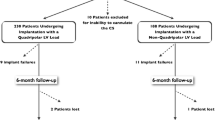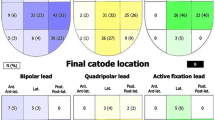Abstract
Background
The use of quadripolar (QP) left ventricular leads for cardiac resynchronization therapy (CRT) is intended to improve outcomes compared with conventional bipolar leads (BP). Hence, the number of implanted quadripolar CRT systems is increasing despite limited long-term data.
Purpose
The aim of this study is to evaluate clinical response and long-term outcomes of CRT recipients who were implanted with quadripolar versus bipolar left ventricular leads.
Methods
Data from consecutive patients receiving a CRT defibrillator in one German and one Hungarian tertiary referral center were retrospectively collected. Long-term survival and response to CRT were analyzed.
Results
A total of 536 patients with structural heart disease and a mean left ventricular ejection fraction (LVEF) of 25% received a CRT defibrillator (CRT-D) system for primary (79%) or secondary (21%) prevention of sudden death. Comorbidities did not differ significantly between patients receiving a QP (n = 123) or a BP lead (n = 413). Procedure (101 vs. 120 min) and fluoroscopy times (14 vs. 20 min) were shorter in patients implanted with QP compared with BP (both p < 0.001). At 6 months follow-up, QP patients were more likely to respond to CRT measured as improvement in the New York Heart Association (NYHA) functional class (77% vs. 63%; p < 0.001). Use of QP left ventricle/left ventricular (LV) leads was associated with greater reduction in QRS duration compared with patients implanted with BP LV leads (− 21 ± 30 vs. − 8 ± 35 ms, p = 0.004). Mortality was not significantly different between patients with QP and patients with BP LV leads at a mean follow-up of 39 ± 31 months.
Conclusion
Implantation of quadripolar left ventricular leads was associated with better CRT response compared with bipolar left ventricular leads.



Similar content being viewed by others
Abbreviations
- ACE-inhibitor:
-
Angiotensin-converting-enzyme inhibitor
- ARB:
-
Angiotensin receptor blocker
- ASA:
-
Acetylsalicylacid
- BP:
-
Bipolar
- BiVPace:
-
Biventricular pacing percentage
- CAD:
-
Coronary artery disease
- CI:
-
Confidence interval
- CKD:
-
Chronic kidney disease (stage III KDIGO, GFR ≤ 59 ml/min)
- CRT:
-
Cardiac resynchronization therapy
- CRT-D:
-
Implantable cardioverter defibrillator with CRT
- FDA:
-
Federal drug association
- HR:
-
Hazard ratio
- ICD:
-
Implantable cardioverter defibrillator
- IRB:
-
Institutional review board
- LBBB:
-
Left bundle branch block
- LMWH:
-
Low-molecular-weight heparin
- LV:
-
Left ventricle/left ventricular
- LVEF:
-
Left ventricular ejection fraction
- LVEDD:
-
Left ventricular end diastolic diameter
- MRAs:
-
Mineralocorticoid receptor antagonists
- NOAC:
-
Non-VKA oral anticoagulant
- NYHA:
-
New York Heart Association functional classification
- PAD:
-
Peripheral artery disease
- QP:
-
Quadripolar
- SCD:
-
Sudden cardiac death
- SD:
-
Standard deviation
- VKA:
-
Vitamin K antagonist
References
Abraham WT, Fisher WG, Smith AL, Delurgio DB, Leon AR, Loh E, et al. Multicenter InSync Randomized Clinical Evaluation. Cardiac resynchronization therapy in chronic heart failure. N Engl J Med. 2002;346:1845–53.
Anand IS, Carson P, Galle E, Song R, Boehmer J, Ghali JK, et al. Cardiac resynchronization therapy reduces the risk of hospitalizations in patients with advanced heart failure: results from the comparison of medical therapy, pacing and defibrillation in heart failure (COMPANION) trial. Circulation. 2009;119:969–77.
Bristow MR, Saxon LA, Boehmer J, Krueger S, Kass DA, De Marco T, et al. Comparison of medical therapy, pacing, and defibrillation in heart failure (COMPANION) Investigators. Cardiac-resynchronization therapy with or without an implantable defibrillator in advanced chronic heart failure. N Engl J Med. 2004;350:2140–50.
Linde C, Abraham WT, Gold MR, Sutton MJ, Ghio S, Daubert C. Randomized trial of cardiac resynchronization in mildly symptomatic heart failure patients and in asymptomatic patients with left ventricular dysfunction and previous heart failure symptoms. JACC. 2008;52:1834–43.
Moss AJ, Hall WJ, Cannom DS, Klein H, Brown MW, Daubert JP, et al. Cardiac resynchronization therapy for the prevention of heart-failure events. N Engl J Med. 2009;363:2385–95.
Healey JS, Hohnloser SH, Exner DV, Birnie DH, Parkash R, Connolly SJ, et al. RAFT investigators. Cardiac resynchronization therapy in patients with permanent atrial fibrillation: results from the resynchronization for ambulatory heart failure Trial (RAFT). Circ Heart Fail. 2005;5:566–70.
Cleland JG, Daubert JC, Erdmann E, Freemantle N, Gras D, Kappenberger L, et al. The effect of cardiac resynchronization on morbidity and mortality in heart failure. N Engl J Med. 2005;352:1539–49.
Ponikowski P, Voors AA, Anker SD, Bueno H, Cleland JGF, Coats AJS, et al. 2016 ESC guidelines for the diagnosis and treatment of acute and chronic heart failure. Eur Heart J. 2016;27:2129–200.
Epstein AE, DiMarco JP, Ellenbogen KA, Estes NA 3rd, Freedman RA, Gettes LS, et al. 2012 ACCF/AHA/HRS focused update incorporated into the ACCF/AHA/HRS 2008 guidelines for device-based therapy of cardiac rhythm abnormalities: a report of the American College of Cardiology Foundation/American Heart Association task force on practice guidelines and the Heart Rhythm Society. Circulation. 2013;127:e283–352.
Sperzel J, Dänschel W, Gutleben KJ, Kranig W, Mortensen P, Connelly D, et al. First prospective, multi-center clinical experience with a novel left ventricular quadripolar lead. Europace. 2012;14:365–72.
Dickstein K, Normand C, Auricchio A, Bogale N, Cleland JG, Gitt AK, et al. CRT survey II: a European Society of Cardiology survey of cardiac resynchronisation therapy in 11 088 patients-who is doing what to whom and how? Eur J Heart Fail. 2018;20:1039–51.
Arias MA, Pachon M, Puchol A, Jimenez-Lopez J, Rodriguez-Padia L. Acute and mid-term outcomes of transvenous implant of a new left ventricular quadripolar lead versus bipolar leads for cardiac resynchronization therapy: results from a single-center prospective database. Cardiol J. 2012;19:470–8.
Behar JM, Bostock J, Zhu Li AP, Chin HM, Jubb S, Lent E, et al. Cardiac resynchronization therapy delivered via a multipolar left ventricular lead is associated with reduced mortality and elimination of phrenic nerve stimulation: long-term follow-up from a multicenter registry. J Cardiovasc Electrophysiol. 2015;26:540–6.
Boriani G, Connors S, Kalarus Z, Lemke B, Mullens W, Asensi JO, et al. Cardiac resynchronization therapy with a quadripolar electrode lead decreases complications at 6 months: Results of the MORE-CRT Randomized Trial. JACC EP. 2016;2:212–20.
Turakhia M, Cao M, Fischer A, Nabutovsky Y, Sloman LS, Dalal N, et al. Reduced mortality associated with quadripolar compared to bipolar left ventricular leads in cardiac resynchronization therapy. JACC EP. 2016;2:426–33.
Rijal S, Wolfe J, Rattan R, Durrani A, Althouse AD, Marroquin OC, et al. Lead related complications in quadripolar versus bipolar left ventricular leads. Indian Pacing Electrophysiol J. 2017;17:3–7.
Forleo GB, Mantica M, Di Biase L, Panattoni G, Della Rocca DG, Papavasileiou LP, et al. Clinical and procedural outcome of patients implanted with a quadripolar left ventricular lead: early results of a prospective multicenter study. Heart Rhythm. 2012;9:1822–8.
Bencardino G, Di Monaco A, Russo E, Colizzi C, Perna F, Pelargonio G, et al. Outcome of patients treated by cardiac resynchronization therapy using a quadripolar left ventricular lead. Circ J. 2012;80:613–8.
Brignole M, Auricchio A, Baron-Esquivias G, Bordachar P, Boriani G, Breithardt OA, et al. 2013 ESC guidelines on cardiac pacing and cardiac resynchronization therapy. Eur Heart J. 2013;34:2281–32.
Author information
Authors and Affiliations
Corresponding author
Ethics declarations
Conflict of interest
J. W. E. reports receiving consulting fees, travel support, and lecture fees from ZOLL Medical, travel grants from St. Jude Medical/Abbott, and lecture fees from Servier and is a fellow of the Boston Scientific Heart Rhythm fellowship program outside the submitted work.
M.V. reports receiving lecture/consulting fees from Bayer, BMS, Daiichi Sankyo, and Pfizer and support attending scientific meetings from Bayer, Daiichi-Sankyo, Egis, Pfizer, and SJM, outside the submitted work.
D. D. has nothing to disclose.
A. P. B. has nothing to disclose.
Z.B. has nothing to disclose.
P. B. has nothing to disclose.
G.Z.D. reports speakers’ bureau from Medtronic, Biotronik, SJM, and Johnson & Johnson outside the submitted work.
S.H.H. reports receiving consulting fees from Bayer, BI, Boston Scientific, BMS, Gilead, J&J, Medtronic, Pfizer, SJM, Sanofi-Aventis, ZOLL Medical, and Cardiome outside the submitted work.
Additional information
Publisher’s note
Springer Nature remains neutral with regard to jurisdictional claims in published maps and institutional affiliations.
Rights and permissions
About this article
Cite this article
Erath, J.W., Vamos, M., Domokos, D. et al. Effects of implantation of quadripolar left ventricular leads on CRT response. J Interv Card Electrophysiol 55, 73–81 (2019). https://doi.org/10.1007/s10840-019-00545-8
Received:
Accepted:
Published:
Issue Date:
DOI: https://doi.org/10.1007/s10840-019-00545-8




